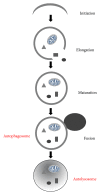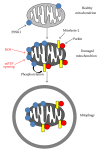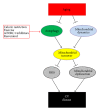New insights into the role of mitochondrial dynamics and autophagy during oxidative stress and aging in the heart
- PMID: 25132912
- PMCID: PMC4124219
- DOI: 10.1155/2014/210934
New insights into the role of mitochondrial dynamics and autophagy during oxidative stress and aging in the heart
Abstract
The heart is highly sensitive to the aging process. In the elderly, the heart tends to become hypertrophic and fibrotic. Stiffness increases with ensuing systolic and diastolic dysfunction. Aging also affects the cardiac response to stress. At the molecular level, the aging process is associated with accumulation of damaged proteins and organelles, partially due to defects in protein quality control systems. The accumulation of dysfunctional and abnormal mitochondria is an important pathophysiological feature of the aging process, which is associated with excessive production of reactive oxygen species. Mitochondrial fusion and fission and mitochondrial autophagy are crucial mechanisms for maintaining mitochondrial function and preserving energy production. In particular, mitochondrial fission allows for selective segregation of damaged mitochondria, which are afterward eliminated by autophagy. Unfortunately, recent evidence indicates that mitochondrial dynamics and autophagy are progressively impaired over time, contributing to the aging process. This suggests that restoration of these mechanisms could delay organ senescence and prevent age-associated cardiac diseases. Here, we discuss the current understanding of the close relationship between mitochondrial dynamics, mitophagy, oxidative stress, and aging, with a particular focus on the heart.
Figures




Similar articles
-
Mitochondrial dynamics: Orchestrating the journey to advanced age.J Mol Cell Cardiol. 2015 Jun;83:37-43. doi: 10.1016/j.yjmcc.2015.04.015. Epub 2015 Apr 24. J Mol Cell Cardiol. 2015. PMID: 25918048 Review.
-
Advanced glycation end products receptor RAGE controls myocardial dysfunction and oxidative stress in high-fat fed mice by sustaining mitochondrial dynamics and autophagy-lysosome pathway.Free Radic Biol Med. 2017 Nov;112:397-410. doi: 10.1016/j.freeradbiomed.2017.08.012. Epub 2017 Aug 19. Free Radic Biol Med. 2017. PMID: 28826719
-
Mitophagy is triggered by mild oxidative stress in a mitochondrial fission dependent manner.Biochim Biophys Acta. 2012 Dec;1823(12):2297-310. doi: 10.1016/j.bbamcr.2012.08.007. Epub 2012 Aug 16. Biochim Biophys Acta. 2012. PMID: 22917578
-
Role of mitochondrial dysfunction and altered autophagy in cardiovascular aging and disease: from mechanisms to therapeutics.Am J Physiol Heart Circ Physiol. 2013 Aug 15;305(4):H459-76. doi: 10.1152/ajpheart.00936.2012. Epub 2013 Jun 7. Am J Physiol Heart Circ Physiol. 2013. PMID: 23748424 Free PMC article. Review.
-
Redox homeostasis, oxidative stress and mitophagy.Mitochondrion. 2020 Mar;51:105-117. doi: 10.1016/j.mito.2020.01.002. Epub 2020 Jan 20. Mitochondrion. 2020. PMID: 31972372 Free PMC article. Review.
Cited by
-
Adult Cardiac Stem Cell Aging: A Reversible Stochastic Phenomenon?Oxid Med Cell Longev. 2019 Feb 7;2019:5813147. doi: 10.1155/2019/5813147. eCollection 2019. Oxid Med Cell Longev. 2019. PMID: 30881594 Free PMC article. Review.
-
SIRT3 Acts as a Positive Autophagy Regulator to Promote Lipid Mobilization in Adipocytes via Activating AMPK.Int J Mol Sci. 2020 Jan 7;21(2):372. doi: 10.3390/ijms21020372. Int J Mol Sci. 2020. PMID: 31936019 Free PMC article.
-
An Intervention Target for Myocardial Fibrosis: Autophagy.Biomed Res Int. 2018 Apr 2;2018:6215916. doi: 10.1155/2018/6215916. eCollection 2018. Biomed Res Int. 2018. PMID: 29850542 Free PMC article. Review.
-
Spermidine supplementation influences mitochondrial number and morphology in the heart of aged mice.J Anat. 2023 Jan;242(1):91-101. doi: 10.1111/joa.13618. Epub 2021 Dec 27. J Anat. 2023. PMID: 34958481 Free PMC article.
-
Atg7 Knockdown Augments Concanavalin A-Induced Acute Hepatitis through an ROS-Mediated p38/MAPK Pathway.PLoS One. 2016 Mar 3;11(3):e0149754. doi: 10.1371/journal.pone.0149754. eCollection 2016. PLoS One. 2016. PMID: 26939081 Free PMC article.
References
-
- Lutz W, Sanderson W, Scherbov S. The coming acceleration of global population ageing. Nature. 2008;451:716–719. - PubMed
-
- Newman AB, Arnold AM, Naydeck BL, et al. “Successful Aging”: effect of subclinical cardiovascular disease. Archives of Internal Medicine. 2003;163(19):2315–2322. - PubMed
-
- Lloyd-Jones D, Adams R, Carnethon M, et al. Heart disease and stroke statistics—2009 update: a report from the American Heart Association Statistics Committee and Stroke Statistics Subcommittee. Circulation. 2009;119(3):e21–e181. - PubMed
-
- Buchberger A, Bukau B, Sommer T. Protein quality control in the cytosol and the endoplasmic reticulum: brothers in arms. Molecular Cell. 2010;40(2):238–252. - PubMed
-
- Denzel MS, Storm NJ, Gutschmidt A, et al. Hexosamine pathway metabolites enhance protein quality control and prolong life. Cell. 2014;156:1167–1178. - PubMed
Publication types
MeSH terms
Substances
Grants and funding
- HL67724/HL/NHLBI NIH HHS/United States
- AG23039/AG/NIA NIH HHS/United States
- R01 HL091469/HL/NHLBI NIH HHS/United States
- P01 AG027211/AG/NIA NIH HHS/United States
- HL69020/HL/NHLBI NIH HHS/United States
- HL91469/HL/NHLBI NIH HHS/United States
- P01 HL069020/HL/NHLBI NIH HHS/United States
- R01 HL067724/HL/NHLBI NIH HHS/United States
- HL102738/HL/NHLBI NIH HHS/United States
- R01 HL112330/HL/NHLBI NIH HHS/United States
- R01 AG023039/AG/NIA NIH HHS/United States
- AG27211/AG/NIA NIH HHS/United States
- R01 HL102738/HL/NHLBI NIH HHS/United States
LinkOut - more resources
Full Text Sources
Other Literature Sources

